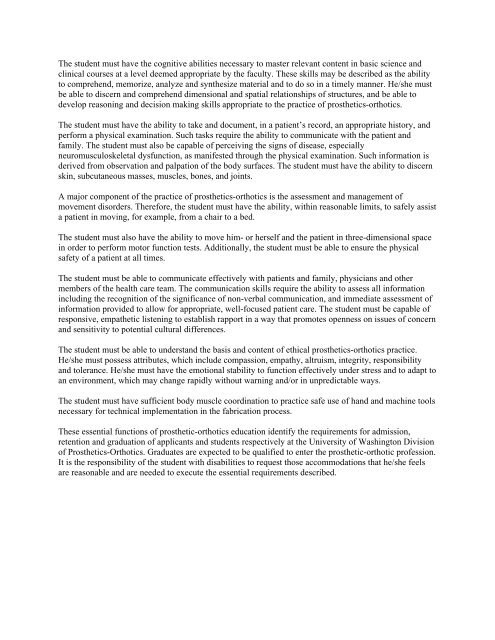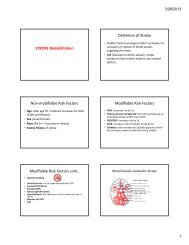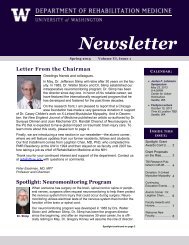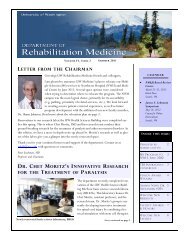Essential Requirements of Prosthetic-Orthotic Education University ...
Essential Requirements of Prosthetic-Orthotic Education University ...
Essential Requirements of Prosthetic-Orthotic Education University ...
You also want an ePaper? Increase the reach of your titles
YUMPU automatically turns print PDFs into web optimized ePapers that Google loves.
The student must have the cognitive abilities necessary to master relevant content in basic science andclinical courses at a level deemed appropriate by the faculty. These skills may be described as the abilityto comprehend, memorize, analyze and synthesize material and to do so in a timely manner. He/she mustbe able to discern and comprehend dimensional and spatial relationships <strong>of</strong> structures, and be able todevelop reasoning and decision making skills appropriate to the practice <strong>of</strong> prosthetics-orthotics.The student must have the ability to take and document, in a patient’s record, an appropriate history, andperform a physical examination. Such tasks require the ability to communicate with the patient andfamily. The student must also be capable <strong>of</strong> perceiving the signs <strong>of</strong> disease, especiallyneuromusculoskeletal dysfunction, as manifested through the physical examination. Such information isderived from observation and palpation <strong>of</strong> the body surfaces. The student must have the ability to discernskin, subcutaneous masses, muscles, bones, and joints.A major component <strong>of</strong> the practice <strong>of</strong> prosthetics-orthotics is the assessment and management <strong>of</strong>movement disorders. Therefore, the student must have the ability, within reasonable limits, to safely assista patient in moving, for example, from a chair to a bed.The student must also have the ability to move him- or herself and the patient in three-dimensional spacein order to perform motor function tests. Additionally, the student must be able to ensure the physicalsafety <strong>of</strong> a patient at all times.The student must be able to communicate effectively with patients and family, physicians and othermembers <strong>of</strong> the health care team. The communication skills require the ability to assess all informationincluding the recognition <strong>of</strong> the significance <strong>of</strong> non-verbal communication, and immediate assessment <strong>of</strong>information provided to allow for appropriate, well-focused patient care. The student must be capable <strong>of</strong>responsive, empathetic listening to establish rapport in a way that promotes openness on issues <strong>of</strong> concernand sensitivity to potential cultural differences.The student must be able to understand the basis and content <strong>of</strong> ethical prosthetics-orthotics practice.He/she must possess attributes, which include compassion, empathy, altruism, integrity, responsibilityand tolerance. He/she must have the emotional stability to function effectively under stress and to adapt toan environment, which may change rapidly without warning and/or in unpredictable ways.The student must have sufficient body muscle coordination to practice safe use <strong>of</strong> hand and machine toolsnecessary for technical implementation in the fabrication process.These essential functions <strong>of</strong> prosthetic-orthotics education identify the requirements for admission,retention and graduation <strong>of</strong> applicants and students respectively at the <strong>University</strong> <strong>of</strong> Washington Division<strong>of</strong> <strong>Prosthetic</strong>s-<strong>Orthotic</strong>s. Graduates are expected to be qualified to enter the prosthetic-orthotic pr<strong>of</strong>ession.It is the responsibility <strong>of</strong> the student with disabilities to request those accommodations that he/she feelsare reasonable and are needed to execute the essential requirements described.






